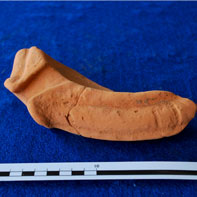Food and farming
The Roman conquest saw the introduction of new foodstuffs into Britain, but the basis of diet would have remain what it always had been – grain. The Vale of Glamorgan is one of the best areas in Wales for growing cereal crops. Fragments of charred grains and chaff found during excavation at Nurston and Castle Wood, Fonmon, on the edge of Cardiff International Airport show that the inhabitants of this Iron Age and Roman settlement were threshing grain, which had probably been grown on their own land. They did not just have themselves to feed – they would have also had to produce food to support the Roman soldiers stationed in the forts. Excavations at Loughor uncovered parts of three granaries, along with some of the grain that had been stored in two of them. Three sorts of wheat were found – bread wheat, spelt and emmer, along with barley, a little bit of rye and (in one of the granaries) a few oats. The wheat would have been ground into flour, mixed into dough for bread and baked in ovens behind the ramparts. Spelt and emmer are very hardy grains, much higher in protein than bread wheat, but their husks are more firmly attached, making them more difficult to thresh. They are also not so good for making bread.
Study of animal bones found on Roman farmsteads tells us about the animals that were being raised for food. At Whitton, more beef was eaten than anything else, and the same at Biglis - sheep and goat were more common here, but as smaller animals they would have produced less meat. The bones from sites in forts and towns usually just tell us about the meat that was eaten there, rather than where they were raised. Bones that ended up in the main drain of the fortress baths at Caerleon show that in the 1st century the soldiers were eating lots of chicken and mutton chops during their visits to the baths (and the chop-bones were well chewed!). However, we do not always have as much information as we would like, because the acidic soils on many sites in our area often dissolve bone away.
Because fish bones are very small, they are not usually found unless a lot of the excavated soil is sieved. None have as yet been identified in South Wales, but shellfish do occur on the more Romanised sites. It looks as though a taste for seafood was something that had been introduced by the Romans. Also introduced was a taste for wine, olive oil and fish sauce, as we can tell from the containers in which they were imported (visit Roman Trade), though again these are mostly found at military sites rather than in small towns or in the country.
Another thing that tells us about different eating cooking and habits is the sort of pottery that is found on different sites. Evidence for oil and wine goes alongside the remains of mortaria, the Roman equivalent of food-processors, showing people on other sites were probably still eating the same sort of food as their Iron Age ancestors.




